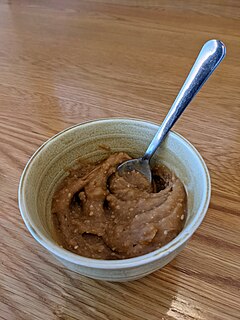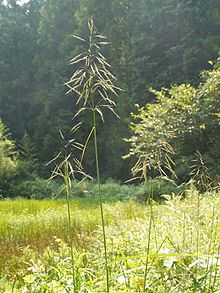
Jean-François Millet was a French artist and one of the founders of the Barbizon school in rural France. Millet is noted for his paintings of peasant farmers and can be categorized as part of the Realism art movement. Toward the end of his career, he became increasingly interested in painting pure landscapes. He is known best for his oil paintings but is also noted for his pastels, conte crayon drawings, and etchings.
Taiwanese cuisine has several variations. The earliest known cuisines of Taiwan are that of the Taiwanese indigenous peoples. Over hundred years of historical development; mainstream Taiwanese cuisine has been influenced by Hakka cuisine, the cuisines of the waishengren, and Japanese cuisine. Although southern Fujian cuisine has had the most profound impact.

Millets are a highly varied group of small-seeded grasses, widely grown around the world as cereal crops or grains for fodder and human food. Most species generally referred to as millets belong to the tribe Paniceae, but some millets also belong to various other taxa.

Eleusine coracana, or finger millet, also known as ragi in India, kodo in Nepal, is an annual herbaceous plant widely grown as a cereal crop in the arid and semiarid areas in Africa and Asia. It is a tetraploid and self-pollinating species probably evolved from its wild relative Eleusine africana.
In the Ottoman Empire, a millet was an independent court of law pertaining to "personal law" under which a confessional community was allowed to rule itself under its own laws.

Pearl millet is the most widely grown type of millet. It has been grown in Africa and the Indian subcontinent since prehistoric times. The center of diversity, and suggested area of domestication, for the crop is in the Sahel zone of West Africa. Recent archaeobotanical research has confirmed the presence of domesticated pearl millet on the Sahel zone of northern Mali between 2500 and 2000 BC.

The Bunun, also historically known as the Vonum, are a Taiwanese indigenous people and are best known for their sophisticated polyphonic vocal music. They speak the Bunun language. Unlike other aboriginal peoples in Taiwan, the Bunun are widely dispersed across the island's central mountain ranges. In the year 2000, the Bunun numbered 41,038. This was approximately 8% of Taiwan's total indigenous population, making them the fourth-largest indigenous group. They have five distinct communities: the Takbunuaz, the Takituduh, the Takibaka, the Takivatan, and the Isbukun.

Foxtail millet, scientific name Setaria italica, is an annual grass grown for human food. It is the second-most widely planted species of millet, and the most grown millet species in Asia. The oldest evidence of foxtail millet cultivation was found along the ancient course of the Yellow River in Cishan, China, carbon dated to be from around 8,000 years before present. Foxtail millet has also been grown in India since antiquity.

A cun, often glossed as the Chinese inch, is a traditional Chinese unit of length. Its traditional measure is the width of a person's thumb at the knuckle, whereas the width of the two forefingers denotes 1.5 cun and the width of four fingers side-by-side is 3 cuns. In this sense it continues to be used to chart acupuncture points on the human body in various uses of traditional Chinese medicine.

The Sakizaya are Taiwanese indigenous peoples with a population of approximately 1,000. They primarily live in Hualien, where their culture is centered.

Chatang or seasoned flour mush is a traditional gruel common to both Beijing cuisine and Tianjin cuisine, and often sold as a snack on the street. It is made from sorghum flour and/or broomcorn millet and/or proso millet flour and glutinous millet flour. The Chinese name is figurative, not literal, as there is neither any tea nor any soup in this dish.

Eulalia is a genus of Asian, African, and Australian plants in the grass family.

Chadian cuisine is the cooking traditions, practices, foods and dishes associated with the Republic of Chad. Chadians use a medium variety of grains, vegetables, fruits and meats. Commonly consumed grains include millet, sorghum, and rice as staple foods. Commonly eaten vegetables include okra and cassava. A variety of fruits are also eaten. Meats include mutton, chicken, pork, goat, fish, lamb and beef. The day's main meal is typically consumed in the evening on a large communal plate, with men and women usually eating in separate areas. This meal is typically served on the ground upon a mat, with people sitting and eating around it.
Millet wine is a common wine in East and Southeast Asia. It is also the oldest wine in Taiwan and a traditional beverage of Taiwanese aborigines. It is often used in harvest festivals, as a symbol of harvest.
Ma La Sun is a brand of millet wine, originally used in Taiwanese Film director Wei Te-sheng's movie 《Cape No. 7》. The phrase "Ma La Sun" originally means "drunk" in Ami language. This product was invented and sold by Farmers' Association in Xinyi, Nantou, with an Advertising slogan "A Thousand Years Tradition. A Brand New Taste."

The Kanakanavu are an indigenous people of central southern Taiwan. They live in the two villages of Manga and Takanua in Namasia District, Kaohsiung City, Taiwan.
Elachista caliginosa is a moth in the family Elachistidae. It was described by Parenti in 1983. It is found in Japan (Honshu) and the Russian Far East.

Aeromachus inachus is a butterfly in the family Hesperiidae (Hesperiinae). It is found in the East Palearctic in Ussuri, Amur, Taiwan, Japan. The larva on feeds on Spodiopogon sibiricus and other Gramineae. There are two or more broods. The larva of this species hibernates.

Spodiopogon formosanus or the Taiwan oil millet is a species of perennial grass in the family Poaceae. It is endemic to Taiwan. It is traditionally grown as a cereal crop by the Taiwanese aborigines.













